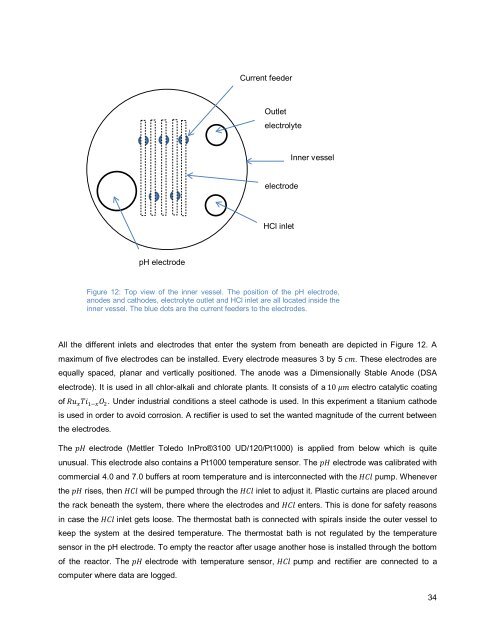A bubble curtain model applied in chlorate electrolysis
A bubble curtain model applied in chlorate electrolysis
A bubble curtain model applied in chlorate electrolysis
You also want an ePaper? Increase the reach of your titles
YUMPU automatically turns print PDFs into web optimized ePapers that Google loves.
Current feeder<br />
Outlet<br />
electrolyte<br />
Inner vessel<br />
electrode<br />
HCl <strong>in</strong>let<br />
pH electrode<br />
Figure 12: Top view of the <strong>in</strong>ner vessel. The position of the pH electrode,<br />
anodes and cathodes, electrolyte outlet and HCl <strong>in</strong>let are all located <strong>in</strong>side the<br />
<strong>in</strong>ner vessel. The blue dots are the current feeders to the electrodes.<br />
All the different <strong>in</strong>lets and electrodes that enter the system from beneath are depicted <strong>in</strong> Figure 12. A<br />
maximum of five electrodes can be <strong>in</strong>stalled. Every electrode measures 3 by 5 cm. These electrodes are<br />
equally spaced, planar and vertically positioned. The anode was a Dimensionally Stable Anode (DSA<br />
electrode). It is used <strong>in</strong> all chlor-alkali and <strong>chlorate</strong> plants. It consists of a 10 μm electro catalytic coat<strong>in</strong>g<br />
of Ru x Ti 1−x O 2 . Under <strong>in</strong>dustrial conditions a steel cathode is used. In this experiment a titanium cathode<br />
is used <strong>in</strong> order to avoid corrosion. A rectifier is used to set the wanted magnitude of the current between<br />
the electrodes.<br />
The pH electrode (Mettler Toledo InPro®3100 UD/120/Pt1000) is <strong>applied</strong> from below which is quite<br />
unusual. This electrode also conta<strong>in</strong>s a Pt1000 temperature sensor. The pH electrode was calibrated with<br />
commercial 4.0 and 7.0 buffers at room temperature and is <strong>in</strong>terconnected with the HCl pump. Whenever<br />
the pH rises, then HCl will be pumped through the HCl <strong>in</strong>let to adjust it. Plastic <strong>curta<strong>in</strong></strong>s are placed around<br />
the rack beneath the system, there where the electrodes and HCl enters. This is done for safety reasons<br />
<strong>in</strong> case the HCl <strong>in</strong>let gets loose. The thermostat bath is connected with spirals <strong>in</strong>side the outer vessel to<br />
keep the system at the desired temperature. The thermostat bath is not regulated by the temperature<br />
sensor <strong>in</strong> the pH electrode. To empty the reactor after usage another hose is <strong>in</strong>stalled through the bottom<br />
of the reactor. The pH electrode with temperature sensor, HCl pump and rectifier are connected to a<br />
computer where data are logged.<br />
34















